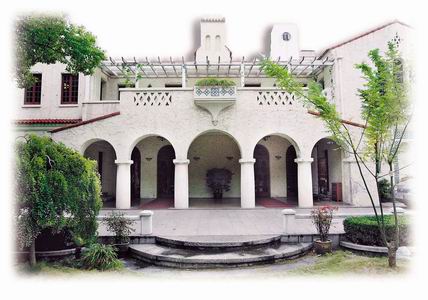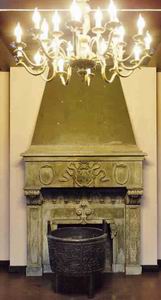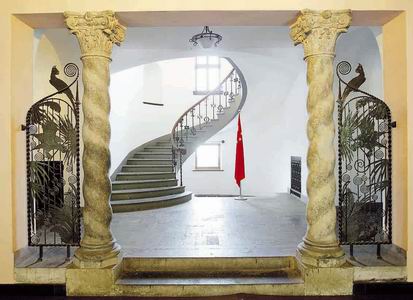


The house at 52 Yongfu Road (top), now home to the
Shanghai Paradise Corp, was once taken by the wealthy Sun brothers. The interior
decor of the building is of the style of the early last century: There¡¯s a large
elaborately carved stone fireplace(left) and in the grand hall on the first
floor are two colossal, twisted stone columns(right).
Its rich interior is seen today in films about old Shanghai, but the story of
the residence and its former owners would also make an interesting screenplay,
writes Michelle Qiao.
Pictures of the house at 52 Yongfu Road look like they
could have been clipped from a travel magazine, perhaps for a story about a
Mediterranean resort.
A niche of green enameled bricks graces a bright yellow
wall - a typical Spanish-style touch - while orange-hued ivy climbs over the
red-tiled building.
The interior decor is straight out of the early part of
the last century - there's a gigantic, elaborately carved stone fireplace and in
the grand hall on the first floor are two colossal, twisted stone
columns.
The columns - together with the wooden decorative columns on the
bookshelves in the reading room and the wooden handrail on the stairs - have a
twisted rope pattern. In addition, there are copper dividers between the columns
and the wall, which have exquisite carvings of birds - mostly eagles - and
animals and plants. The ceiling of the hall has exposed wooden beams.
On the
second floor, most of the rooms have large ensuite bathrooms and each room has a
door leading to the next room.
The house and its spacious, lush garden is now
the office of the Shanghai Paradise Corp, the city's leading film distribution
company which has maintained the residence in good shape, retaining the original
fireplace, doors, windows and even the built-in bookshelves.
"We don't use
any bright lamps inside the house, only those with a gentle yellowish lighting,"
says Guo Ruxing, a manager for the company. "There used to be two
big camphor-laurel trees and a 500-square-meter swimming pool in the
2,000-square-meter garden.
"The pool was filled in to build more buildings
and one of the camphor-laurel tree died during the 'cultural revolution'
(1966-76). The surviving tree has a shade area of 500 square meters," he
says.
There are only a few records in the archives about the past history of
the beautiful residence.
Qian zonghao, associate research professor at
Shanghai History Museum, says: "I have only been able to find records in English
about the early days of the house from stories in the old North China Daily
News. The newspaper clippings say the renowned American architect Elliott
Hazzard built the house in 1932. The first residents were Mr and Mrs R. Buchan,
who owned Allan & Buchan, a currency and bullion brokerage. In 1939 they
sold the house to a Chinese named C.S. Tung, who was a foreign exchange
broker."
According to Chinese author Song Luxia in the book, "Shanghai's Old
Foreign Houses," the house was later taken over by the wealthy Sun brothers as
their residence.
Sun duoxin and his brother Sun Duosen came from an
influential family in Anhui Province. One of their ancestors was teacher of the
Emperor Guangxu (1871-1908) in the Qing Dynasty (1644-1911). The brothers'
grandfather, Li Hanzhang, was the elder brother of Li Hongzhang, prime minister
and chief representative in foreign affairs in the last years of the Qing
era.
The brothers were inspired by the success of the Zengyu Flour Factory
established by foreign enterprises in 1894 in Yangshupu in the city's
northeastern Yangpu District. They studied the wheat industry and even traveled
overseas to study flour-making technology. Finally, they decided to import
machinery from the United States for an enormous price of US$220,000 and built
an American-designed factory.
In 1898, they opened the Fuxing Flour Company
on Moganshan Road, the first Chinese-owned flour mill and factory in Shanghai.
The company could produce up to 47,000 sacks of flour every day and was the
largest flour mill in China at that time.
Warlord yuan Shih-kai asked Sun
Duosen to work for him and Sun was made first president of the China Bank from
December 1912 to June 1913.
After liberation in 1949, the Fuxing Flour
Company became a joint firm in 1955 and in 1966 changed its named to the
Shanghai Flour Company.
"Many films have been shot here and it is often shown
as the home of a wealthy lady," says Guo.
Perhaps the real history of the
house and its past residents would also make an interesting movie.



